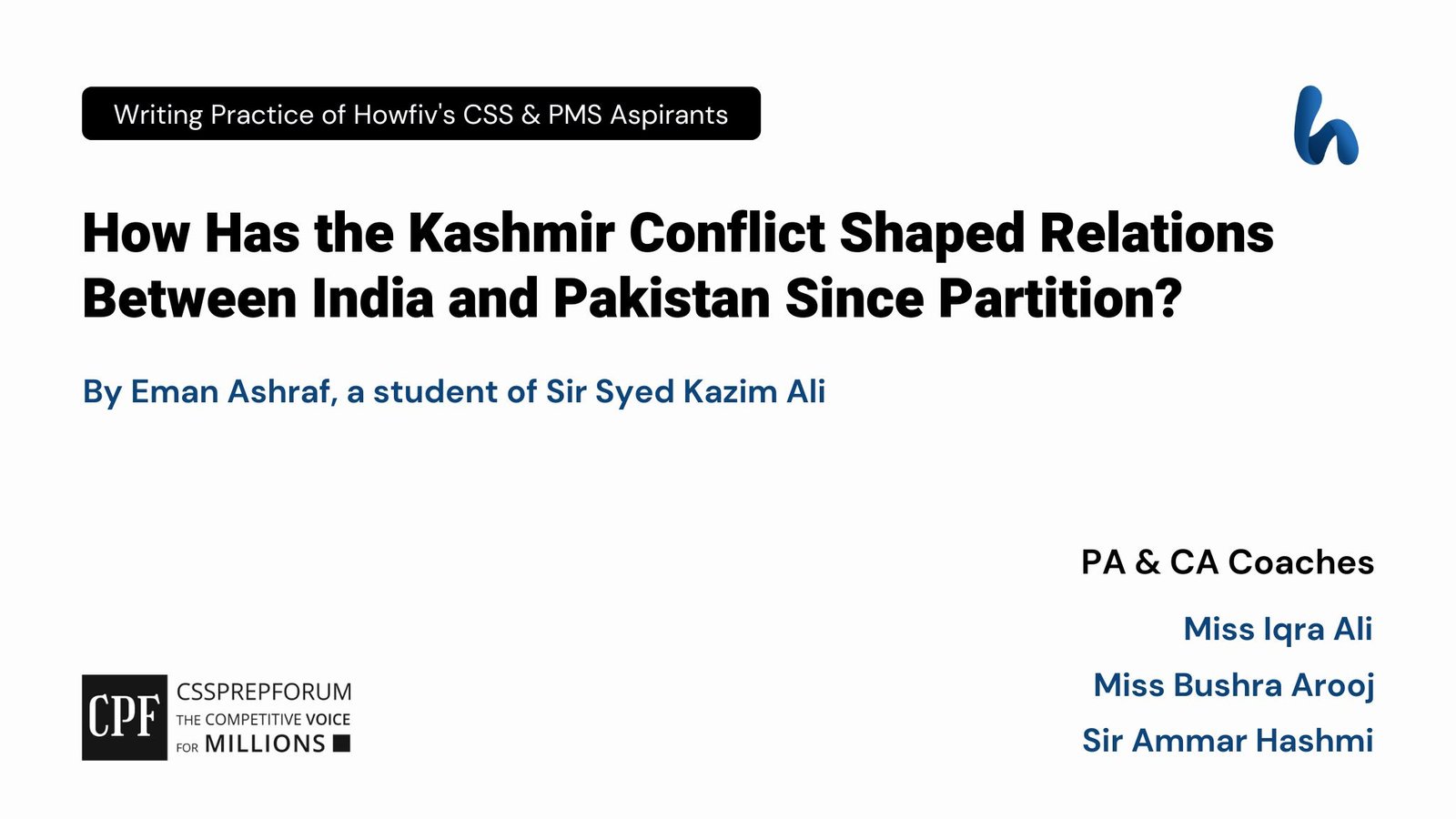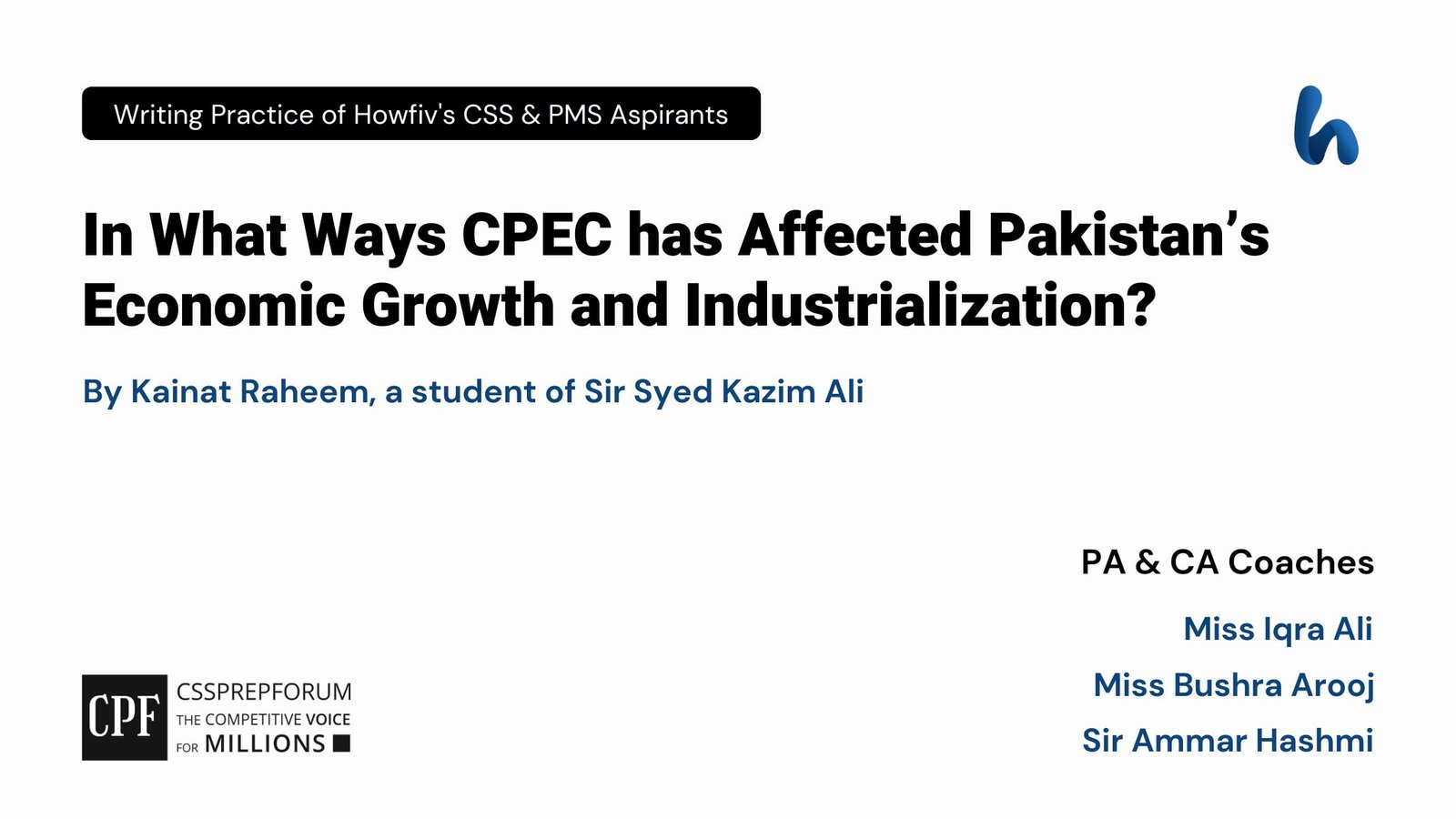CSS Current Affairs | Key Factors that Led to the Arab-Israel Wars and Their Influence
The following question of CSS Current Affairs is solved by Safina Naz under the supervision of Howfiv’s Pakistan Affairs and Current Affairs Coaches. She learnt how to attempt 20 marks question and essay writing from Sir Syed Kazim Ali, Pakistan’s best CSS and PMS English essay and precis teacher with the highest success rate of his students. This solved past paper question is attempted on the pattern taught by Sir to his students, scoring the highest marks in compulsory and optional subjects for years, and uploaded to help aspirants understand how to crack a topic or question, how to write relevantly, what coherence is, and how to include and connect ideas, opinions, and suggestions to score the maximum.

Outline
1- Introduction
2- Disentangling the Israel-Palestine issue by tracing the historical roots
3- What are the prominent factors behind the Arab-Israel wars- 1948, 1967, and 1973?
- ✓Expanding the Jewish occupation on Palestinian land
- ✓Increasing intent of taking control of Jerusalem
- ✓Mounting issue of Palestinian refugees
- ✓Rising nationalist sentiment among Arabs and Zionists
4- How have the Arab-Israel wars influenced the territorial and political landscape of the region-Middle East?
- ✓Increasing Israel’s control over Palestinian land
- ✓ Strengthening the Palestinian Liberation Organization (PLO) and other non-state actors
- ✓Rise of Arabism in the Middle Eastern region
5- Critical Analysis
6- Conclusion

Answer to the Question
Introduction
Palestine, a holy land, holds paramount significance for the people of three different religions: Islam, Christianity, and Judaism. For ages, the believers of these three religions have been contesting and waging wars for Jerusalem, a city in Palestine; however, the Palestine issue got impetus in the 20th century, with the rise of the Zionist influx in the Palestinian land, consequently disrupting regional stability. The conflict reached its peak when the United Nations gave its partition plan for dividing Palestine into Jewish and Palestine states, providing a breeding ground for the Arab-Israel conflict of 1984, 1967, and 1973. Nonetheless, along with the partition plan, several other factors acted concurrently and led to the wars. Among them, the most prominent one is the deprivation of Arabs of their lands and the issue of Palestinian refugees. Consequently, Arabs paid the high cost of these wars in the form of increased expansion of Zionists on the Palestinian territory. Moreover, the wars ended with the rise of non-state actors in the region, changing Palestine’s territorial and political landscape. Thus, the trajectory of the Arab-Israel conflict portrays an abysmal picture, pointing towards a dire need to address the matter with the mediation of international powers. This question provides a brief insight into the Arab-Israel wars and their ultimate impacts on the territorial and political landscape of the Middle East.
Disentangling the Israel-Palestine issue by tracing the historical roots
Before moving in depth, it is essential to trace the historical roots of the Palestine issue. Palestine is a religiously and geographically significant piece of land. Based on religious significance, it hosts the sentiments of Muslims, Jews, and Christians. Speaking of Muslims, Al-Aqsa Mosque, which is situated in Jerusalem, is of cardinal importance for Muslims. On the other hand, believing that Hazrat Esa was crucified in Jerusalem, Christians consider it a holy place. Similarly, Jerusalem is sacred for Jews owing to the presence of Jewish temples in the past, with Jews having a belief in reconstructing the Dome of Rock, the third temple, by demolishing the Al-Aqsa Mosque. Thus, the contrasting religious allegiances are the driving forces responsible for what is currently happening in Palestine. With the onset of the 20th century, Jews previously moved to Europe and started coming back to Palestinian land aimed at getting their land back. It is noteworthy to mention that Britain assisted Zionist Jews through certain efforts, such as passing the Balford Declaration, in bringing them back to the holy land. As a result, the continuous influx of Jews and their constant struggles to occupy the Palestinian lands led to heightened insecurities among the Arabs, eventually leading to souring peace in the region, curtailing Palestinian rights and forcing them to live in sub-standard conditions. Hence, the situation in Palestine is the upshot of the religious affiliation of Muslims, Christians, and Jews with Palestine.
What are the prominent factors behind the Arab-Israel wars- 1948, 1967, and 1973?
- ✓Expanding the Jewish occupation on Palestinian land
Stepping into the depth of the matter, rising differences between Jews and Palestinians gave rise to the War of 1948 when the UN partition plan was presented to divide the Palestinian land between Jews and Palestinians and the subsequent wars of 1967 and 1973. Though fought in different course of time, the prominent reasons that led to the wars were the same. Mentioning them, the most significant reason was the forced settlement by Israel into Palestine. Instead of getting a territory as per the UN partition plan, Israel waged war to expand its boundaries, leading to a massive-scale war starting on 15th May 1948. In the war, Israeli military forces used dynamic war tactics to frighten the Palestinians, eventually occupying 60% of the Palestinian area. Analogously, Israel occupied the Arab territories in the six-day war of 1967, taking hold of the Gaza Strip and the Senai peninsula from Egypt and the West Bank from Jordan. On the flip side, Arab states attacked in the war of 1973, attempting to get their pre-occupied areas back. Thus, the pertinent factor leading to the Arab-Israel wars was the tactful occupation of Israel on Arab lands, aimed at expanding the hold of Israel on Palestinian lands.
- ✓Increasing intent of taking control of Jerusalem
Further, the association of Jews and Palestinians with the holy city of Jerusalem and attempts to take control of Jerusalem were the reasons that laid the foundation of the Arab-Israel wars. With the onset of Jewish settlements in Palestine, concerns over the control of Jerusalem heightened. Though initially started at a low pace, Zionist settlements peaked with the UN partition plan, which deprived the Palestinians of their land and divided their land into two pieces, increasing insecurity about the holy city. Hence, Israel and Arabs went on three decisive wars in 1948, 1967, and 1973 aimed at getting their hands on Jerusalem and fulfilling their religious agenda. Thus, the wars were nothing but a continuation of decades-old religious rivalry between Jews and Palestinians over the piece of land.
- ✓Mounting issue of Palestinian refugees
Moreover, the refugee crisis further cemented the Palestine issue, setting the baseline for Arab-Israel wars. Palestinians were forced to move out of their villages owing to Israel’s forced occupation, eventually displacing some 713,000 and 300,000 Palestinians in 1948 and 1967, respectively. Thus, the massive outflow of Palestinians from their homelands was another prominent factor that led to the Arab-Israel wars.
- ✓Rising nationalist sentiment among Arabs and Zionists
Besides, the nationalist sentiments of Palestinians and Jews galvanized both sides, exacerbating the situation and leading to the wars. Palestinians, being the land owners, felt threatened and waged wars to extricate the Jews from their land. On the other end, Jews, the propagator of the Zionist agenda of getting their land back, waged wars to expand their territorial boundaries. However, all three wars of 1948, 1967, and 1973 culminated with an enormous loss to Palestinian people, displacing, depriving, and curtailing their freedom to live on their land. Hence, the rising uniting force of nationalism in both Arabs and Palestinians played a crucial role in the Arab-Israel wars.
How have the Arab-Israel wars influenced the territorial and political landscape of the region-Middle East?
- ✓Increasing Israel’s control over Palestinian land
Heading towards the impacts of the Arab-Israel wars, these wars tremendously changed the territorial landscape of Palestine. Continuous use of force by Israel led to massive territorial expansion of Israel, with Palestinians losing a significant proportion of their lands. It is evident from the fact that by the end of the 1973 war, Israel took over the Golan Heights from Syria and the Senai Peninsula from Egypt. Further, Israel occupied the East and the West Jerusalem. Hence, the Arab wars culminated by depriving Arabs of their lands and forcing them to live in limited land areas.
- ✓ Strengthening the Palestinian Liberation Organization (PLO) and other non-state actor
In addition, the establishment of the Palestine Liberation Organization (PLO) underscores the shift in the political landscape due to the Arab-Israel wars. The non-state actors, under the umbrella of PLO, started working for the cause of Palestine, aimed at protecting the rights of Arabs. Taking an example, PLO, from its bases in Jordan, launched attacks on Israel to get the land area back from Israel. In addition, the leader of PLA, Yasir Arafat, made extravagant efforts to secure the Arab lands. Along with the formation of PLO, other non-state actors also gained prominence in the regions, leading to the formation of Hamas in successive years. Thus, the formation of PLO owing to continuous war was a uniting force working for the Arab cause.
- ✓Rise of Arabism in the Middle Eastern region
Moreover, the subjugation of Arabs by Israel in the wars created a sense of togetherness in Arabs, promoting Arab nationalism. The occupation of the Golan Heights of Syria, the Senai Peninsula of Egypt, the West Bank of Jordan, and above all, the land of Palestinians was a binding force that gathered all the Arabs under the umbrella of Arabism. Thus, along with creating huge land losses, the wars of 1948, 1967, and 1973 played a paramount role in promoting Arab nationalism.
Critical Analysis
In the robust analysis, Arab Israel wars mark a dark chapter in the history of Palestine, involving mass killings of Palestinians and their subjugation. The constant occupation forced Palestinians to leave their lands, leading to Palestinian outflow in the different regions of the globe. Taking an instance, 6 million Palestinians have been displaced from their homes and forced to live substandard lives. Analyzing the situation, the subjugation of Palestinians at the hands of Israel seems like another holocaust, where the problem is getting worse with every passing day. Therefore, it is the need of the hour that international organizations must investigate the matter and take pragmatic steps to get rid of the corona in Israel. Otherwise, the holocaust will continue, and Palestine will continue to bleed.
Conclusion
At the crux of the matter, the Palestine issue of the current times has roots in the 20th-century wars, making it an intractable problem of the day. Multiple reasons, including territorial expansion by Israel, perceived territorial threat to Palestinians, and violation of Palestinian rights, led to the 1948 war, Nakba, 1967 war, the Six-day War, and the 1973 war, Yom Kippur War, creating a chaotic situation in the region and ultimately disrupting the regional peace. On one hand, these wars ended with the territorial expansion of Israel; however, on the other hand, these wars promoted Arab nationalism and united the Arabs. In addition, the creation of the PLA is among the significant political developments during the historical Arab wars. The situation of the current times is no different when Israel is killing Palestinians on a huge scale, restricting them to a limited area and curtailing their rights. The situation of today seems like another Nakba, leading to the massive displacement of Palestinians and leaving them homeless. Shortly, the problem is portraying a horrific picture. Therefore, interventions by international organizations are highly needed to put an end to the ongoing holocaust.

CSS Solved Past Papers’ Essays
Looking for the last ten years of CSS and PMS Solved Essays and want to know how Sir Kazim’s students write and score the highest marks in the essays’ papers? Then, click on the CSS Solved Essays to start reading them.
CSS Solved Essays
CSS Solved General Science & Ability Past Papers
Want to read the last ten years’ General Science & Ability Solved Past Papers to learn how to attempt them and to score high? Let’s click on the link below to read them all freely. All past papers have been solved by Pakistan’s top CSS GSA coach having the highest score of their students.
General Science & Ability Solved Past Papers












